Publications
Publications contents:
Classic Works:
Sino-Tibetan Linguistics, Appendix VI, Volume 12:2
Alfred L. Kroeber (sponsor)
Robert Shafer and Paul K. Benedict (supervisors)
 Sino-Tibetan Linguistics is the rare, multi-volume culmination of the WPA "Sino-Tibetan Linguistics Project", sponsored by the anthropologist Alfred L. Kroeber and administered by Robert Shafer and Paul K. Benedict at the University of California, Berkeley. The STL team spent their time in the 1930's combing through dictionaries and wordlists to assemble all the material then available on TB languages, and to venture a division of the family into subgroups.
Sino-Tibetan Linguistics is the rare, multi-volume culmination of the WPA "Sino-Tibetan Linguistics Project", sponsored by the anthropologist Alfred L. Kroeber and administered by Robert Shafer and Paul K. Benedict at the University of California, Berkeley. The STL team spent their time in the 1930's combing through dictionaries and wordlists to assemble all the material then available on TB languages, and to venture a division of the family into subgroups.
Eight copies of STL were produced using a typewriter making 7 carbon copies. One set is (apparently) at the Library of Congress. Library records indicate that there is one copy at the Main Library and one at the East Asian Libary here at UC Berkeley. Paul Benedict appears to have had the original set, and Jim Matisoff at STEDT became the owner of at least several volumes when he acquired Benedict's library after his untimely death. One of STEDT's dreams is to digitize these for public dissemination. For now, we are offering a pdf scan of Appendix VI from Volume 12:2 (1939), regarding Pyu.
Benedict & Shafer 1939-1941
University of California (15 volumes)
Download Volume 12:2, Appendix VI ("Pyu")
Sino-Tibetan: A Conspectus
Paul K. Benedict
Contributing Editor, James A. Matisoff
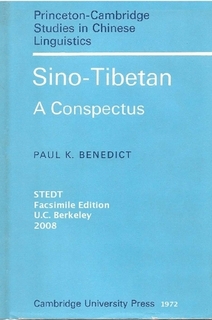 STEDT facsimile edition, of the 1978 hardcover version, reprinted by permission. From the original dust jacket: The first comprehensive account of Sino-Tibetan, a language stock comparable in size and diversification to Indo-European and comprising Chinese, Karen and over a hundred Tibeto-Burman languages. Dr. Benedict presents a systematic analysis of the morphology and phonology of the main descendants of the stock, traces their family relationships and reconstructs in outline the parent language, Sino-Tibetan. There is a glossary of Tibeto-Burman roots and an English-Tibeto-Burman index, which should prove of especial value as a working-tool for scholars. The present book was first drafted many years ago. Dr. Benedict has since made extensive annotations on the original manuscript, and Professor James A. Matisoff has added many notes on bibliography and the Burmese-Lolo group of languages.
STEDT facsimile edition, of the 1978 hardcover version, reprinted by permission. From the original dust jacket: The first comprehensive account of Sino-Tibetan, a language stock comparable in size and diversification to Indo-European and comprising Chinese, Karen and over a hundred Tibeto-Burman languages. Dr. Benedict presents a systematic analysis of the morphology and phonology of the main descendants of the stock, traces their family relationships and reconstructs in outline the parent language, Sino-Tibetan. There is a glossary of Tibeto-Burman roots and an English-Tibeto-Burman index, which should prove of especial value as a working-tool for scholars. The present book was first drafted many years ago. Dr. Benedict has since made extensive annotations on the original manuscript, and Professor James A. Matisoff has added many notes on bibliography and the Burmese-Lolo group of languages.
Benedict 1972
Download this work (12 MiB)
Order a hardcopy from Lulu
Variational Semantics in Tibeto-Burman: The "organic" approach to linguistic comparison
James A. Matisoff
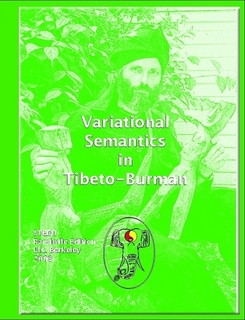 This is a STEDT Facsimile Edition of James A. Matisoff's pioneering 1978 book Variational Semantics in Tibeto-Burman: The "organic" approach to linguistic comparison. This volume explores strategies for sub-grouping Tibeto-Burman (TB) languages, addressing phonological, morphological, and morphophonemic criteria for determining genetic relations. Matisoff here defines many of the key concepts underlying his influential linguistic theories and findings, including "semantic fields", "semantic systems", and "multi-dimensional semantic space", looking in particular at TB body-part terms, and charting the complex semantic relations among TB internal organs.
This is a STEDT Facsimile Edition of James A. Matisoff's pioneering 1978 book Variational Semantics in Tibeto-Burman: The "organic" approach to linguistic comparison. This volume explores strategies for sub-grouping Tibeto-Burman (TB) languages, addressing phonological, morphological, and morphophonemic criteria for determining genetic relations. Matisoff here defines many of the key concepts underlying his influential linguistic theories and findings, including "semantic fields", "semantic systems", and "multi-dimensional semantic space", looking in particular at TB body-part terms, and charting the complex semantic relations among TB internal organs.
Matisoff 1978
Download this work (44 MiB)
Order a hardcopy from Lulu
Books from UC Press:
The Tibeto-Burman Reproductive System: Toward an Etymological Thesaurus
James A. Matisoff
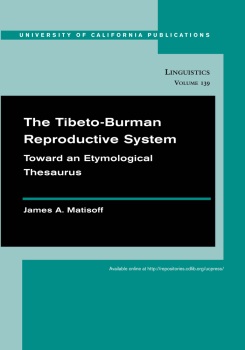 This pioneering book is the prototype of the etymological thesaurus that has been the goal of the STEDT project since 1987. It presents nearly 170 Proto-Tibeto-Burman etymologies in the semantic area of the reproductive system, along with discussions of possible Chinese cognates. Special attention is paid to patterns of semantic associations between the reproductive system and other areas of the lexicon.
This pioneering book is the prototype of the etymological thesaurus that has been the goal of the STEDT project since 1987. It presents nearly 170 Proto-Tibeto-Burman etymologies in the semantic area of the reproductive system, along with discussions of possible Chinese cognates. Special attention is paid to patterns of semantic associations between the reproductive system and other areas of the lexicon.
Matisoff 2008
University of California publications in linguistics ; v. 140.
xli, 259 p. : ill. ; 26 cm.
Includes bibliographical references (p. 249-257).
Order from UC Press | Read online/download
Handbook of Proto-Tibeto-Burman: System and Philosophy of Sino-Tibetan Reconstruction
James A. Matisoff
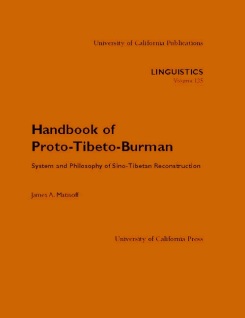 This 800-page volume is a clear and readable presentation of the current state of research on the history of the Tibeto-Burman (TB) language family, a typologically diverse group of over 250 languages spoken in Southern China, the Himalayas, NE India, and peninsular Southeast Asia. The TB languages are the only proven relatives of Chinese, with which they form the great Sino-Tibetan family.
This 800-page volume is a clear and readable presentation of the current state of research on the history of the Tibeto-Burman (TB) language family, a typologically diverse group of over 250 languages spoken in Southern China, the Himalayas, NE India, and peninsular Southeast Asia. The TB languages are the only proven relatives of Chinese, with which they form the great Sino-Tibetan family.
The exposition is systematic, treating the reconstruction of all the elements of the TB proto-syllable in turn, including initial consonants (Ch. III), prefixes (Ch. IV), monophthongal and diphthongal rhymes (Ch. V), final nasals (Ch. VII), final stops (Ch. VIII), final liquids (Ch. IX), root-final *-s (Ch. X), suffixes (Ch. XI). Particular attention is paid to variational phenomena at all historical levels (e.g. Ch. XII "Allofamic variation in rhymes").
This Handbook builds on the best previous scholarship, and adds up-to-date material that has accumulated over the past 30 years. It contains reconstructions of over a thousand Tibeto-Burman roots, as well as suggested comparisons with several hundred Chinese etyma. It is liberally indexed and cross-referenced for maximum accessibility and internal consistency.
Emphasis is placed on the special theoretical issues involved in historical reconstruction in the East/Southeast Asian linguistic area.
Matisoff 2003
University of California publications in linguistics ; v. 135.
xlii, 750 p. ; 29 cm.
Includes bibliographical references (p. 723-750) and indexes.
The first set of Addenda and Corrigenda for this book is available here.
Order from UC Press | Read online/download
English-Lahu Lexicon
James A. Matisoff
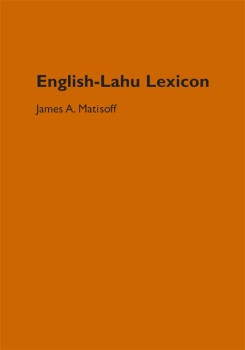 Lahu is an important minority language of Southeast Asia, belonging to the Lolo-Burmese subgroup of the Sino-Tibetan language family. It is spoken by over 500,000 people in China, Burma, Thailand, Laos and Vietnam.
Lahu is an important minority language of Southeast Asia, belonging to the Lolo-Burmese subgroup of the Sino-Tibetan language family. It is spoken by over 500,000 people in China, Burma, Thailand, Laos and Vietnam.
This English-Lahu Lexicon (ELL) is a computer-aided but manually edited "reversal" of the author's monumental Lahu-English dictionary (The Dictionary of Lahu, UCPL #111, 1988, xxv + 1436 pp.).
English-Lahu Lexicon contains nearly 5400 head-entries and well over 10,000 carefully arranged subentries. Every Lahu expression is provided with a form-class designation to indicate its grammatical function. Eight useful Appendices (e.g. Plant and Animal Names) round out the volume's 450 pages.
Matisoff 2006
University of California publications in linguistics ; v. 139.
xxxvi, 472 p. ; 27 cm.
Includes bibliographical references (p. 409-410).
Order from UC Press | Read online/download
The Dictionary of Lahu
James A. Matisoff
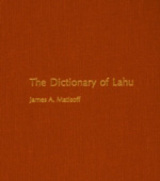 The Lahu are a hill-dwelling Tibeto-Burman people whose language reflects the influence of Thai and Chinese, yet retains a unique beauty and expressive power of its own. The Dictionary of Lahu is one of the most exhaustive and sophisticated dictionaries yet produced for a Southeast Asian language. Together with the author's The Grammar of Lahu (UCPL vol. 75, 1973/1982), it places Lahu among the best documented minority languages of the world.
The Lahu are a hill-dwelling Tibeto-Burman people whose language reflects the influence of Thai and Chinese, yet retains a unique beauty and expressive power of its own. The Dictionary of Lahu is one of the most exhaustive and sophisticated dictionaries yet produced for a Southeast Asian language. Together with the author's The Grammar of Lahu (UCPL vol. 75, 1973/1982), it places Lahu among the best documented minority languages of the world.
Matisoff 1988
University of California publications in linguistics ; v. 111.
xxv, 1436, [28] p. of plates : ill. ; 27 cm.
Bibliography: p. 1415-1436.
Out Of Print | Read online at UC Press or Google Books
The Grammar of Lahu
James A. Matisoff
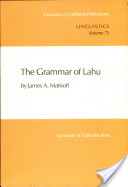 A revised and updated (1973, 1982) edition of Matisoff's pioneering PhD dissertation (A grammar of the Lahu language, 1967, UC Berkeley), based on extensive fieldwork in Northern Thailand (1965-1966, 1970, 1977). Lahu belongs to the Central Loloish language branch of Tibeto-Burman and is spoken in scattered communities across southeast Asia, including southwestern China, eastern Burma, northern Thailand, and northwestern Laos.
A revised and updated (1973, 1982) edition of Matisoff's pioneering PhD dissertation (A grammar of the Lahu language, 1967, UC Berkeley), based on extensive fieldwork in Northern Thailand (1965-1966, 1970, 1977). Lahu belongs to the Central Loloish language branch of Tibeto-Burman and is spoken in scattered communities across southeast Asia, including southwestern China, eastern Burma, northern Thailand, and northwestern Laos.
The language described in this book is spoken in three Christian villages of Chiang Mai Province inhabited by Black Lahu who migrated from the Kengtung area of Shan State, Burma in the 1950's and 1960's. This language corresponds in nearly every particular to the 'standard Black Lahu' used in the various missionary translations of the New Testament.
Matisoff 1973/1982
University of California publications in linguistics ; v. 75.
li, 673 p. illus. 26 cm.
Bibliography: p. 667-673.
Out Of Print | Read online at Google Books
STEDT Monograph Series
The STEDT Project publishes a Monograph Series. Volumes in the STEDT Monograph Series are now available as free pdf downloads. (See License Information.) Hardcopies may also be ordered through the STEDT Lulu Store.
Download a zip archive of all available monographs (36 MiB)
STEDT Monograph 10:
Proto Northern Chin
Christopher Button
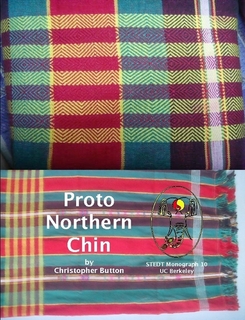 Number 10 in the STEDT Monograph Series presents Proto Northern Chin. This represents a thoroughly updated and revised version of Christopher Button’s 2009 doctoral dissertation (School of Oriental and African Studies, University of London). The work is based on fieldwork conducted by Button in Burma (2006-07) on six Northern Chin languages (Mizo, Zahau, Thado, Zo, Tedim, Sizang) and is divided into two sections. Volume 1, An Old Burmese and Old Chinese Perspective, includes chapters on Northern Chin Phonology, Northern Chin Morphology, Old Burmese, Old Chinese, Sino-Tibetan/Tibeto-Burman, and concludes with a list of Sino-Tibetan Comparative Sets. Volume 2, An Etymological Dictionary of Northern Chin, is devoted entirely to Proto Northern Chin reconstructions, arranged in Proto Northern Chin alphabetical order and by English glosses.
Number 10 in the STEDT Monograph Series presents Proto Northern Chin. This represents a thoroughly updated and revised version of Christopher Button’s 2009 doctoral dissertation (School of Oriental and African Studies, University of London). The work is based on fieldwork conducted by Button in Burma (2006-07) on six Northern Chin languages (Mizo, Zahau, Thado, Zo, Tedim, Sizang) and is divided into two sections. Volume 1, An Old Burmese and Old Chinese Perspective, includes chapters on Northern Chin Phonology, Northern Chin Morphology, Old Burmese, Old Chinese, Sino-Tibetan/Tibeto-Burman, and concludes with a list of Sino-Tibetan Comparative Sets. Volume 2, An Etymological Dictionary of Northern Chin, is devoted entirely to Proto Northern Chin reconstructions, arranged in Proto Northern Chin alphabetical order and by English glosses.
Button 2011
ISBN 0-944613-49-7
200 pages
Download this monograph (3 MiB) | License
Order a hardcopy from Lulu
STEDT Monograph 9:
The Eastern Han Chinese Grammaticon
Richard Cook
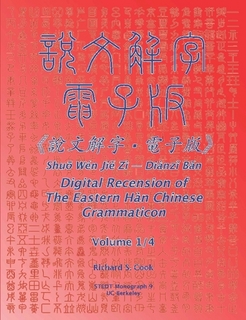 Number 9 in the STEDT Monograph Series is a high-resolution edition of《說文解字 ‧ 電子版》Shuō Wén Jiě Zì — Diànzǐ Bǎn: Digital Recension of the Eastern Hàn Chinese Grammaticon, by Richard S. Cook (Doctoral Dissertation, UC Berkeley, Dept. of Linguistics, 2003). This work, the first-ever reconstruction of a complete Shuō Wén (AD 121) Urtext, presents the results of more than a decade of effort directed at elucidating the major findings of the principal 清 Qīng Dynasty commentary edition (段玉裁 Duàn Yùcái, 1815). In four-volumes (2,400 pages), this monograph situates the 19th c. findings firmly in the context of traditional and modern Chinese lexicography, with complete mappings to important lexica, and Old and Middle Chinese readings. Volume 1 documents the recension and phonological findings; Volumes 2 & 3 contain the concordance data and source mappings; Volume 4 (now available for the first time) contains the complete reconstructed Shuō Wén Urtext typeset in Seal Script (vertical text, right-to-left). Each of the four volumes must be ordered separately.
Number 9 in the STEDT Monograph Series is a high-resolution edition of《說文解字 ‧ 電子版》Shuō Wén Jiě Zì — Diànzǐ Bǎn: Digital Recension of the Eastern Hàn Chinese Grammaticon, by Richard S. Cook (Doctoral Dissertation, UC Berkeley, Dept. of Linguistics, 2003). This work, the first-ever reconstruction of a complete Shuō Wén (AD 121) Urtext, presents the results of more than a decade of effort directed at elucidating the major findings of the principal 清 Qīng Dynasty commentary edition (段玉裁 Duàn Yùcái, 1815). In four-volumes (2,400 pages), this monograph situates the 19th c. findings firmly in the context of traditional and modern Chinese lexicography, with complete mappings to important lexica, and Old and Middle Chinese readings. Volume 1 documents the recension and phonological findings; Volumes 2 & 3 contain the concordance data and source mappings; Volume 4 (now available for the first time) contains the complete reconstructed Shuō Wén Urtext typeset in Seal Script (vertical text, right-to-left). Each of the four volumes must be ordered separately.
Cook 2009
ISBN 0-944613-48-9
2400 pages
This work is not available for free download.
Order hardcopies of the four volumes from Lulu.
STEDT Monograph 8:
Proto-Kuki-Chin: A Reconstructed Ancestor of the Kuki-Chin Languages
Kenneth VanBik
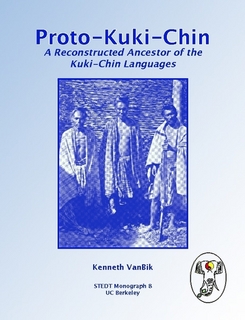 Volume 8 in the STEDT Monograph Series presents Proto-Kuki-Chin: A Reconstructed Ancestor of the Kuki-Chin Languages, a revision of Kenneth VanBik’s 2006 doctoral dissertation (Department of Linguistics, UC Berkeley). This book represents a high-water mark in our understanding of the history of the Kuki-Chin branch of Tibeto-Burman. Nearly 1400 reconstructed cognate sets are presented, at various taxonomic levels: Proto-Kuki-Chin, Proto-Central-Chin, Proto-Northern-Chin, and Proto-Maraic. Special attention is paid to the subgrouping of this highly ramified family, based on the patterns of shared phonological innovations which the various languages display.
Volume 8 in the STEDT Monograph Series presents Proto-Kuki-Chin: A Reconstructed Ancestor of the Kuki-Chin Languages, a revision of Kenneth VanBik’s 2006 doctoral dissertation (Department of Linguistics, UC Berkeley). This book represents a high-water mark in our understanding of the history of the Kuki-Chin branch of Tibeto-Burman. Nearly 1400 reconstructed cognate sets are presented, at various taxonomic levels: Proto-Kuki-Chin, Proto-Central-Chin, Proto-Northern-Chin, and Proto-Maraic. Special attention is paid to the subgrouping of this highly ramified family, based on the patterns of shared phonological innovations which the various languages display.
VanBik 2009
ISBN 0-944613-47-0
626 pages
Download this monograph (4 MiB) | License
Order a hardcopy from Lulu
STEDT Monograph 7:
A Descriptive Grammar of Daai Chin
Helga So-Hartmann
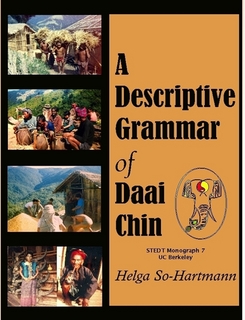 Volume 7 in the STEDT Monograph Series presents A Descriptive Grammar of Daai Chin, Helga So-Hartmann’s 2008 doctoral dissertation (School of Oriental and African Studies, University of London). This is the most detailed and sophisticated grammar of a Chin language to have appeared since Eugénie J.A. Henderson’s classic (1965) study of Tiddim (Northern Chin group). The Daai language is an important member of the Southern Chin group, with about 45,000 speakers. Chin State is in western Myanmar, and the Daai Chin people live in the interior of the Southern Chin Hills in about 160 villages spread out over the four townships Mindat, Kanpetlet, Paletwa and Matupi.)
Volume 7 in the STEDT Monograph Series presents A Descriptive Grammar of Daai Chin, Helga So-Hartmann’s 2008 doctoral dissertation (School of Oriental and African Studies, University of London). This is the most detailed and sophisticated grammar of a Chin language to have appeared since Eugénie J.A. Henderson’s classic (1965) study of Tiddim (Northern Chin group). The Daai language is an important member of the Southern Chin group, with about 45,000 speakers. Chin State is in western Myanmar, and the Daai Chin people live in the interior of the Southern Chin Hills in about 160 villages spread out over the four townships Mindat, Kanpetlet, Paletwa and Matupi.)
So-Hartmann 2009
ISBN 0-944613-46-2
392 pages
Download this monograph (2 MiB) | License
Order a hardcopy from Lulu
STEDT Monograph 6:
Kinship in Southeastern Asia
Paul K. Benedict
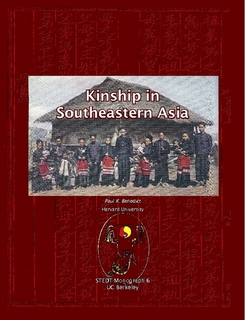 Volume 6 in the STEDT Monograph Series presents a facsimile edition of the ground-breaking Kinship in Southeastern Asia (1941, doctoral dissertation, Department of Anthropology, Harvard University), by the late Paul K. Benedict (1912-1997). This expansive volume treats kinship terms in Tibeto-Burman (which it divides into Tibetan, Western Sub-Himalayan, Eastern Sub-Himalayan, Lepcha, Miri and northern Assam, Kachin, Nung, Burmese and Lolo, Konyak, Garo and Bodo, Mikir, Meithei, Mru, Kuki, Naga) on the one hand, and Karen and Chinese on the other. "The approach in the present work might be termed the 'direct method', in that each language or language-group is handled as a unit, along with the relevant ethnographic data, and an attempt is made to view the nomenclature as a functional entity with intra-relationships as well as extra-relationships. In this way a succession of patterns is presented rather than a series of disembodied etymologies or disjointed sets of sibling terms, grandparent terms, and the like. The comparative side is not lost sight of, however, and the writer does not shy at historical reconstruction. His approach is based, not on any metaphysic of kinship, but on practical expediency. He simply sees no other way of creating a complete picture of the culturo-linguistic situation with which he is faced. The linguistic material has been made especially full with the same end in mind. It must not be forgotten that kinship terms are, after all, linguistic elements, even though they are often handled more as if they were fish-traps or types of arrow release, and that linguistic coloring is all-important in shaping the semantic associations of any given term." (quoted from the author's Introduction, p. iv)
Volume 6 in the STEDT Monograph Series presents a facsimile edition of the ground-breaking Kinship in Southeastern Asia (1941, doctoral dissertation, Department of Anthropology, Harvard University), by the late Paul K. Benedict (1912-1997). This expansive volume treats kinship terms in Tibeto-Burman (which it divides into Tibetan, Western Sub-Himalayan, Eastern Sub-Himalayan, Lepcha, Miri and northern Assam, Kachin, Nung, Burmese and Lolo, Konyak, Garo and Bodo, Mikir, Meithei, Mru, Kuki, Naga) on the one hand, and Karen and Chinese on the other. "The approach in the present work might be termed the 'direct method', in that each language or language-group is handled as a unit, along with the relevant ethnographic data, and an attempt is made to view the nomenclature as a functional entity with intra-relationships as well as extra-relationships. In this way a succession of patterns is presented rather than a series of disembodied etymologies or disjointed sets of sibling terms, grandparent terms, and the like. The comparative side is not lost sight of, however, and the writer does not shy at historical reconstruction. His approach is based, not on any metaphysic of kinship, but on practical expediency. He simply sees no other way of creating a complete picture of the culturo-linguistic situation with which he is faced. The linguistic material has been made especially full with the same end in mind. It must not be forgotten that kinship terms are, after all, linguistic elements, even though they are often handled more as if they were fish-traps or types of arrow release, and that linguistic coloring is all-important in shaping the semantic associations of any given term." (quoted from the author's Introduction, p. iv)
Benedict 2008
ISBN 0-944613-45-4
545 pages
Please email us to obtain a free pdf of this monograph.
Order a hardcopy from Lulu
STEDT Monograph 5:
Classical Chinese Combinatorics: Derivation of the Book of Changes Hexagram Sequence
Richard S. Cook
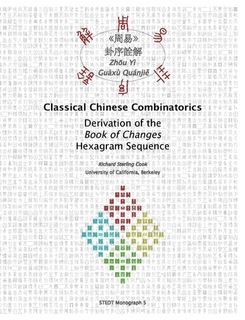 The first and most enigmatic of the Chinese classics is the Book of Changes, and the reasoning behind its binary hexagram sequence remained an unsolved mystery for some 3,000 years (according to the tradition ascribing it to King Wen of Zhou, d. -11th c.). This Monograph resolves the classical enigma: Richard Cook provides a comprehensive analysis of the hexagram sequence, showing that its classification of binary sequences demonstrates knowledge of the convergence of certain linear recurrence sequences (LRS; Pingala -5th c.?, Fibonacci 1202) to division in extreme and mean ratio (DEMR, the “Golden Section” irrational; Pythagoras -6th c.?, Euclid -4th c.). It is shown that the complex hexagram sequence encapsulates a careful and ingenious demonstration of the LRS/DEMR relation, that this knowledge results from general combinatorial analysis, and is reflected in elements emphasized in ancient Chinese and Western mathematical traditions. This copiously illustrated 660-page volume presents a detailed introduction to the classical problem, an overview and in-depth derivation of the solution, an extensive terminological glossary, and computer source code formalizing all aspects of the derivations. The conclusion of this work situates the major findings in larger historical context.
The first and most enigmatic of the Chinese classics is the Book of Changes, and the reasoning behind its binary hexagram sequence remained an unsolved mystery for some 3,000 years (according to the tradition ascribing it to King Wen of Zhou, d. -11th c.). This Monograph resolves the classical enigma: Richard Cook provides a comprehensive analysis of the hexagram sequence, showing that its classification of binary sequences demonstrates knowledge of the convergence of certain linear recurrence sequences (LRS; Pingala -5th c.?, Fibonacci 1202) to division in extreme and mean ratio (DEMR, the “Golden Section” irrational; Pythagoras -6th c.?, Euclid -4th c.). It is shown that the complex hexagram sequence encapsulates a careful and ingenious demonstration of the LRS/DEMR relation, that this knowledge results from general combinatorial analysis, and is reflected in elements emphasized in ancient Chinese and Western mathematical traditions. This copiously illustrated 660-page volume presents a detailed introduction to the classical problem, an overview and in-depth derivation of the solution, an extensive terminological glossary, and computer source code formalizing all aspects of the derivations. The conclusion of this work situates the major findings in larger historical context.
Cook 2006
ISBN 0-944613-44-6
660 pages
This work is not available for free download.
Order a hardcopy from Lulu
STEDT Monograph 4:
Southern Lisu Dictionary
David Bradley
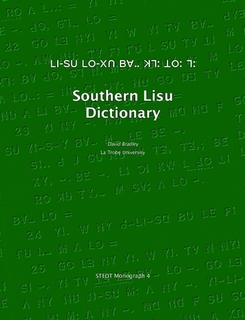 Lisu is one of the most important and viable Loloish languages, with nearly a million speakers, but until recently comparative Loloish studies have been hampered by the lack of a comprehensive dictionary of the language. David Bradley, who has already done much to clarify the interrelationships among the Lolo-Burmese languages as a whole, has been working to fill this lexicographical lacuna for more than a decade. In 1994, he published a concise 257-page dictionary of Northern Lisu. The present work treats the Southern dialect. The front matter includes an informative introduction about the Lisu people and their dialectal subdivisions, and a brief sketch of Lisu syntax. The body of the 346-page Southern Lisu Dictionary is carefully arranged, with clear glosses for both the lemmata and the subentries, providing intriguing glimpses into Lisu culture.
Lisu is one of the most important and viable Loloish languages, with nearly a million speakers, but until recently comparative Loloish studies have been hampered by the lack of a comprehensive dictionary of the language. David Bradley, who has already done much to clarify the interrelationships among the Lolo-Burmese languages as a whole, has been working to fill this lexicographical lacuna for more than a decade. In 1994, he published a concise 257-page dictionary of Northern Lisu. The present work treats the Southern dialect. The front matter includes an informative introduction about the Lisu people and their dialectal subdivisions, and a brief sketch of Lisu syntax. The body of the 346-page Southern Lisu Dictionary is carefully arranged, with clear glosses for both the lemmata and the subentries, providing intriguing glimpses into Lisu culture.
Bradley 2005
ISBN 0-944613-43-8
xxxiv, 346 pages
Download this monograph (2 MiB) | License
Order a hardcopy from Lulu
STEDT Monograph 3:
Phonological Inventories of Tibeto-Burman Languages
Ju Namkung, Editor
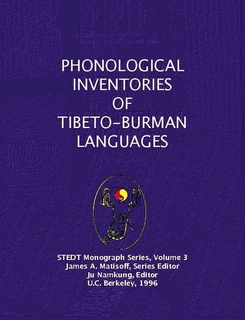 Contains phonological information on over 150 Tibeto-Burman languages and dialects, gathered from numerous published and unpublished sources. The monograph has a two-fold purpose. First, it will serve as a companion to forthcoming STEDT volumes, providing a key to the various transcription systems employed in the STEDT database. Second, it can stand on its own as a general reference tool which gathers in a single volume 270 treatments of Tibeto-Burman phonological systems, each comprising symbols and their phonetic values, interpretive notes, and sources. In addition, the monograph is indexed by language and dialect name, by subgroup and by STEDT source abbreviation, making it a convenient and invaluable reference for the Tibeto-Burman linguist.
Contains phonological information on over 150 Tibeto-Burman languages and dialects, gathered from numerous published and unpublished sources. The monograph has a two-fold purpose. First, it will serve as a companion to forthcoming STEDT volumes, providing a key to the various transcription systems employed in the STEDT database. Second, it can stand on its own as a general reference tool which gathers in a single volume 270 treatments of Tibeto-Burman phonological systems, each comprising symbols and their phonetic values, interpretive notes, and sources. In addition, the monograph is indexed by language and dialect name, by subgroup and by STEDT source abbreviation, making it a convenient and invaluable reference for the Tibeto-Burman linguist.
Namkung, ed. 1996
ISBN 0-944613-28-4
xxviii, 507 pages
Download this monograph (1 MiB) | License
Order a hardcopy from Lulu
STEDT Monograph 2:
Languages and Dialects of Tibeto-Burman
James A. Matisoff, Editor
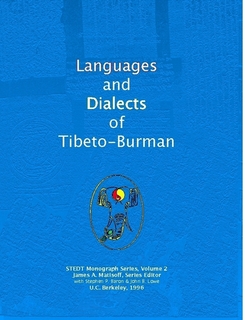 A substantially revised version of Matisoff's 1986 list of Tibeto-Burman languages, published in Contributions to Sino-Tibetan Studies (John McCoy and Timothy Light (Eds.), Leiden: E. J. Brill). The work includes 1,294 main entries with thousands of additional cross-references, ethnolinguistic details, and "allonyms" (Matisoff's term for the various referents used for languages and peoples). Also included are bibliographic citations and statistics relating the names in the work to the contents of the Sino-Tibetan Etymological Dictionary and Thesaurus (STEDT) project database, making the work a useful companion to the forthcoming Dictionary-Thesaurus.
A substantially revised version of Matisoff's 1986 list of Tibeto-Burman languages, published in Contributions to Sino-Tibetan Studies (John McCoy and Timothy Light (Eds.), Leiden: E. J. Brill). The work includes 1,294 main entries with thousands of additional cross-references, ethnolinguistic details, and "allonyms" (Matisoff's term for the various referents used for languages and peoples). Also included are bibliographic citations and statistics relating the names in the work to the contents of the Sino-Tibetan Etymological Dictionary and Thesaurus (STEDT) project database, making the work a useful companion to the forthcoming Dictionary-Thesaurus.
Matisoff, ed. 1996
ISBN 0-944613-26-8
xxx, 180 pages
Download this monograph (1 MiB) / with original article as an appendix (22 MiB) | License
Order a hardcopy from Lulu
STEDT Monograph 1A:
Bibliography of the International Conferences on Sino-Tibetan Languages and Linguistics I-XXV
Randy J. LaPolla and John B. Lowe (Eds.)
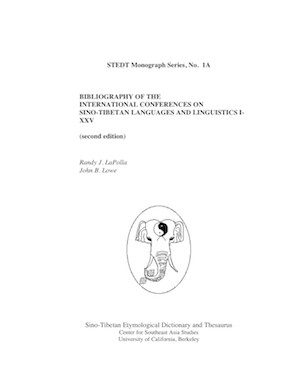 Covers the first twenty-five International Conferences on Sino-Tibetan Languages and Linguistics (ICSTLL), from the first held at Yale in 1968 to the 25th held at Berkeley in 1992. In addition to a full bibliography of all papers presented, it includes indexes by author, subject, title, and Chinese character. A chronological listing of papers by conference is also provided.
Covers the first twenty-five International Conferences on Sino-Tibetan Languages and Linguistics (ICSTLL), from the first held at Yale in 1968 to the 25th held at Berkeley in 1992. In addition to a full bibliography of all papers presented, it includes indexes by author, subject, title, and Chinese character. A chronological listing of papers by conference is also provided.
This is the 2nd edition, superseding Monograph 1: Bibliography of the International Conferences on Sino-Tibetan Languages and Linguistics I-XXI (LaPolla & Lowe, eds. 1989).
LaPolla & Lowe, eds. 1994
lxiv, 308 pages
This book is currently out of print, but hardcopies are available at cost by sending us email here at STEDT. We have recovered a version of the original text and this (slightly imperfect) PDF version is available here.
License Information
With the exceptions of Monographs 5 & 9, you are free to download, store, print, and distribute (at no charge and without modification) STEDT Monographs for research and academic purposes. Any publication or product which makes use of these monographs must include proper attribution. Commercial use of these works is prohibited unless explicit permission has been obtained from STEDT.
The STEDT Lulu Store is in place to provide a convenient method for obtaining a hardcopy. You may also download the monographs and take them to a copy shop yourself, if you prefer.
If the STEDT Monograph you are interested in is not available for download or purchase, please email STEDT to let us know!
Inquiries may also be directed to:
|
STEDT Publications c/o STEDT Project Department of Linguistics 1203 Dwinelle Hall #2652 University of California Berkeley, CA 94720-2652 |
Phone: (510) 643-9910 Fax: (510) 643-9911 E-mail: stedt@berkeley.edu |




